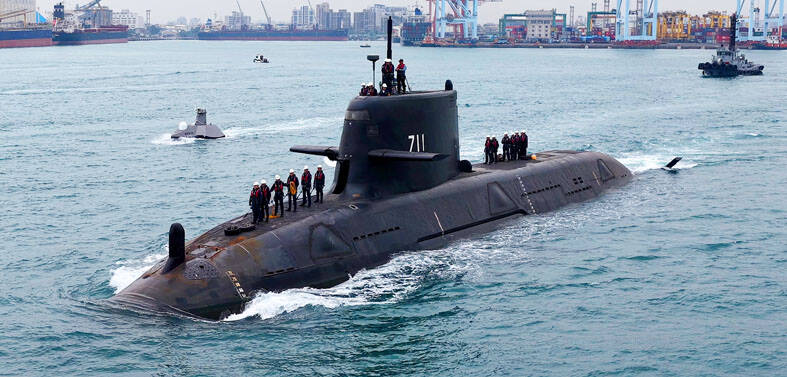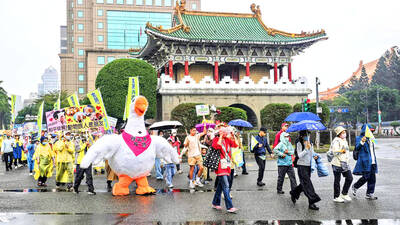Chinese tourists visiting the two frontline islands of Kinmen and Matsu will be granted landing visas or multi-entry visas by the end of this month, but they won’t be permitted to enter Taiwan proper with the visas, an official said yesterday.
The measure was part of a proposal aimed at establishing closer ties across the Taiwan Strait and approved by the weekly Cabinet meeting yesterday.
Also included in the proposal were measures to normalize the small three links — direct communications, transportation and trade links between Kinmen and Matsu and Fuzhou, Xiamen and Quanzhou in China’s Fujian Province.
Mainland Affairs Council Chairwoman Lai Shin-yuan (賴幸媛), whose agency drafted the proposal, said it was in line with the “peace statement” President Ma Ying-jeou (馬英九) made to mark the recent 50th anniversary of the bombardment of Kinmen.
In light of recent efforts at cross-strait reconciliation, peace and cooperation, Kinmen, Matsu, Xiamen, Fuzhou and the areas surrounding Fujian will gradually become a “common living circle,” for which it would be necessary to normalize the small three links, Lai said.
Under the proposal, Chinese tourists and experts invited to participate in cultural and academic exchanges would be allowed to visit Taiwan via Kinmen and Matsu starting at the end of this month.
Currently, the traveling route is confined only to residents of Fujian Province.
“That way, we can provide Chinese residents more convenient channels to travel to the country and help them reduce transportation costs,” Lai said.
The government will also lift tariffs on low-volume trade of agricultural and aquatic products imported from China to Kinmen and Matsu and simplify customs procedures in a bid to put an end to the prevalent smuggling of such products, Lai said.
Starting in the middle of October, the measures applied to Kinmen and Matsu will be extended to Penghu, for which the links are currently implemented on a case-by-case basis, Lai said.
Lai said that the government was confident that Taiwan and China would start direct sea transportation by the end of this year and that liberalization of the small three links would help the islands withstand any economic impact this may have on them.

NUMBERS IMBALANCE: More than 4 million Taiwanese have visited China this year, while only about half a million Chinese have visited here Beijing has yet to respond to Taiwan’s requests for negotiation over matters related to the recovery of cross-strait tourism, the Tourism Administration said yesterday. Taiwan’s tourism authority issued the statement after Chinese-language daily the China Times reported yesterday that the government’s policy of banning group tours to China does not stop Taiwanese from visiting the country. As of October, more than 4.2 million had traveled to China this year, exceeding last year. Beijing estimated the number of Taiwanese tourists in China could reach 4.5 million this year. By contrast, only 500,000 Chinese tourists are expected in Taiwan, the report said. The report

Temperatures are forecast to drop steadily as a continental cold air mass moves across Taiwan, with some areas also likely to see heavy rainfall, the Central Weather Administration (CWA) said. From today through early tomorrow, a cold air mass would keep temperatures low across central and northern Taiwan, and the eastern half of Taiwan proper, with isolated brief showers forecast along Keelung’s north coast, Taipei and New Taipei City’s mountainous areas and eastern Taiwan, it said. Lows of 11°C to 15°C are forecast in central and northern Taiwan, Yilan County, and the outlying Kinmen and Lienchiang (Matsu) counties, and 14°C to 17°C

STEERING FAILURE: The first boat of its class is experiencing teething issues as it readies for acceptance by the navy, according to a recent story about rudder failure The Hai Kun (海鯤), the nation’s first locally built submarine, allegedly suffered a total failure of stern hydraulic systems during the second round of sea acceptance trials on June 26, and sailors were forced to manually operate the X-rudder to turn the submarine and return to port, news Web site Mirror Daily reported yesterday. The report said that tugboats following the Hai Kun assisted the submarine in avoiding collisions with other ships due to the X-rudder malfunctioning. At the time of the report, the submarine had completed its trials and was scheduled to begin diving and surfacing tests in shallow areas. The X-rudder,

DEMAND: The government should enact regulations in line with Austria and Germany to incorporate vegan nutrition into school meals, an advocate said More than 1,000 people yesterday marched in Taipei to promote veganism, calling for legislation to incorporate vegan diets into school lunches and the national net zero emissions program. Participants gathered on Ketagalan Boulevard in front of the Presidential Office Building for the march, which was organized by the Vegan Action Network (VAN). Former ambassador to Chad Chiu Chung-jen (邱仲仁), actor Yankee Yang (楊子儀) and actress Cindy Lien (連俞涵) attended the event. VAN member Marianne Chao (趙梅君) said that the campaign aimed to urge the government to promote vegan diets across schools and government agencies via legislation and national policies, which would help build